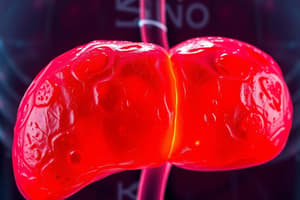Podcast
Questions and Answers
Where is alcohol primarily metabolized?
Where is alcohol primarily metabolized?
- Kidneys
- Heart
- Liver (correct)
- Brain
What are the two principal enzymes involved in alcohol metabolism?
What are the two principal enzymes involved in alcohol metabolism?
- Alcohol dehydrogenase (ADH) and Cytochrome P450
- Cytochrome P450 and Catalase
- Alcohol dehydrogenase (ADH) and Aldehyde dehydrogenase (ALDH2) (correct)
- Aldehyde dehydrogenase (ALDH2) and Catalase
What determines the effects of alcohol on the body?
What determines the effects of alcohol on the body?
- The type of alcohol consumed
- The amount of alcohol consumed
- The rate of alcohol absorption
- The concentration of alcohol in the blood over time (correct)
What is the result of chronic alcohol consumption and alcohol metabolism?
What is the result of chronic alcohol consumption and alcohol metabolism?
What is the byproduct produced by alcohol dehydrogenase enzyme during alcohol metabolism?
What is the byproduct produced by alcohol dehydrogenase enzyme during alcohol metabolism?
Where is aldehyde dehydrogenase (ALDH2) located in the cell?
Where is aldehyde dehydrogenase (ALDH2) located in the cell?
What is required for the oxidation process of ethanol metabolism by ADH?
What is required for the oxidation process of ethanol metabolism by ADH?
What is the byproduct produced by aldehyde dehydrogenase (ALDH2) enzyme during alcohol metabolism?
What is the byproduct produced by aldehyde dehydrogenase (ALDH2) enzyme during alcohol metabolism?
Flashcards are hidden until you start studying
Study Notes
Alcohol Metabolism
- The effects of alcohol depend on its concentration in the blood (BAC) over time.
- BAC is determined by the rates of alcohol absorption, distribution, metabolism, and excretion.
- The liver is the primary site of alcohol metabolism.
Enzymes Involved in Alcohol Metabolism
- The two main enzymes involved in alcohol metabolism are alcohol dehydrogenase (ADH) and aldehyde dehydrogenase (ALDH2).
- ADH is present in the liver cytosol and has multiple variants (isozymes).
- ALDH2 is present in the mitochondria.
Metabolism of Ethanol
- Ethanol is metabolized by ADH to produce acetaldehyde, a highly reactive and toxic byproduct.
- Acetaldehyde production can contribute to tissue damage and the addictive process.
- The metabolism of ethanol by ADH requires NAD+, which is reduced by two electrons to form NADH.
Metabolism of Acetaldehyde
- Acetaldehyde is metabolized by ALDH2 to produce acetate.
- The metabolism of acetaldehyde by ALDH2 requires NAD+, which is reduced by two electrons to form NADH.
Extrahepatic Metabolism
- Alcohol can also be metabolized in non-liver tissues, such as the brain, by enzymes like cytochrome P450 and catalase.
- These tissues do not contain ADH.
Pathological Consequences
- Chronic alcohol consumption and metabolism are linked to several pathological consequences and tissue damage.
- Tissue damage can result from the formation of reactive oxygen species (ROS) and changes in the reduction-oxidation (redox) state of liver cells.
Studying That Suits You
Use AI to generate personalized quizzes and flashcards to suit your learning preferences.



